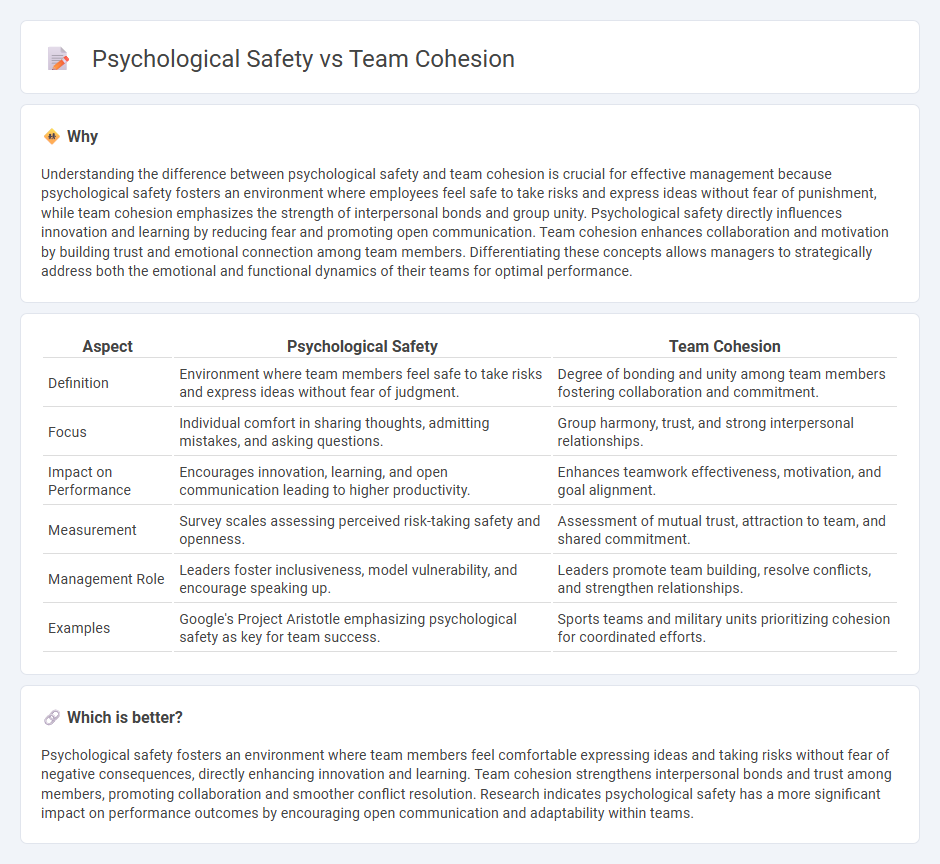
Psychological safety fosters an environment where team members feel comfortable expressing ideas and taking risks without fear of negative consequences, which directly enhances innovation and problem-solving. Team cohesion refers to the strength of relationships and the alignment of group goals, promoting collaboration and mutual support in achieving objectives. Explore how balancing psychological safety and team cohesion can transform organizational performance.
Why it is important
Understanding the difference between psychological safety and team cohesion is crucial for effective management because psychological safety fosters an environment where employees feel safe to take risks and express ideas without fear of punishment, while team cohesion emphasizes the strength of interpersonal bonds and group unity. Psychological safety directly influences innovation and learning by reducing fear and promoting open communication. Team cohesion enhances collaboration and motivation by building trust and emotional connection among team members. Differentiating these concepts allows managers to strategically address both the emotional and functional dynamics of their teams for optimal performance.
Comparison Table
| Aspect | Psychological Safety | Team Cohesion |
|---|---|---|
| Definition | Environment where team members feel safe to take risks and express ideas without fear of judgment. | Degree of bonding and unity among team members fostering collaboration and commitment. |
| Focus | Individual comfort in sharing thoughts, admitting mistakes, and asking questions. | Group harmony, trust, and strong interpersonal relationships. |
| Impact on Performance | Encourages innovation, learning, and open communication leading to higher productivity. | Enhances teamwork effectiveness, motivation, and goal alignment. |
| Measurement | Survey scales assessing perceived risk-taking safety and openness. | Assessment of mutual trust, attraction to team, and shared commitment. |
| Management Role | Leaders foster inclusiveness, model vulnerability, and encourage speaking up. | Leaders promote team building, resolve conflicts, and strengthen relationships. |
| Examples | Google's Project Aristotle emphasizing psychological safety as key for team success. | Sports teams and military units prioritizing cohesion for coordinated efforts. |
Which is better?
Psychological safety fosters an environment where team members feel comfortable expressing ideas and taking risks without fear of negative consequences, directly enhancing innovation and learning. Team cohesion strengthens interpersonal bonds and trust among members, promoting collaboration and smoother conflict resolution. Research indicates psychological safety has a more significant impact on performance outcomes by encouraging open communication and adaptability within teams.
Connection
Psychological safety fosters an environment where team members feel comfortable sharing ideas and taking risks without fear of negative consequences, directly enhancing team cohesion by building trust and open communication. High team cohesion strengthens collaboration and supports a culture of mutual respect, which reinforces psychological safety. Organizations that prioritize psychological safety typically experience higher levels of team engagement, innovation, and overall performance.
Key Terms
Trust
Trust serves as the foundational element distinguishing team cohesion and psychological safety, with cohesion emphasizing mutual respect and loyalty among members, while psychological safety prioritizes the confidence to take risks and express ideas without fear of judgment. High trust levels foster open communication, collaboration, and resilience within both frameworks, but psychological safety uniquely promotes innovation by reducing interpersonal fear. Discover how enhancing trust can simultaneously boost your team's cohesion and psychological safety for optimal performance.
Communication
Effective communication is crucial for fostering team cohesion and psychological safety, enabling open dialogue and trust among members. Team cohesion strengthens collective goals and collaboration, while psychological safety encourages risk-taking and the sharing of ideas without fear of judgment. Explore how communication strategies can balance and enhance both to improve your team's performance.
Belonging
Team cohesion enhances belonging by fostering trust and collaboration among members, creating a unified group identity. Psychological safety promotes a culture where individuals feel secure to express ideas and take risks without fear of judgment, deepening their sense of inclusion. Explore how balancing team cohesion and psychological safety can strengthen belonging and improve overall team performance.
Source and External Links
Team Cohesion & Strategies for Team Bonding - Team cohesion is the strength and extent of interpersonal connection among group members, driving motivation and readiness to achieve shared goals, and can be understood through aspects like multidimensionality, dynamics, instrumental focus, and emotional bonds.
What is Team Cohesion & How to Achieve it - Team cohesion refers to a team's ability to stay united and function as a single unit toward a common objective, relying on effective communication, trust, and a sense of belonging among members.
10 Ways To Improve Team Cohesiveness in the Workplace - Team cohesiveness means a team works effectively as a whole toward a common goal, with signs including quick conflict resolution, a strong "we" mentality, personal accountability, organizational prioritization, and high levels of trust.
 dowidth.com
dowidth.com